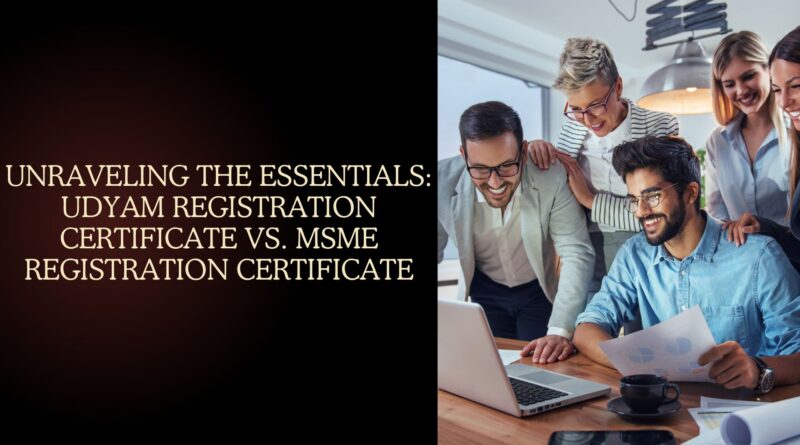Udyam Registration vs. MSME Registration
In the labyrinth of India’s economic landscape, small and medium-sized enterprises (SMEs) play a pivotal role in driving growth, fostering innovation, and generating employment. To provide a conducive environment for their sustenance and expansion, the Indian government has instituted various schemes and frameworks. Among these, the Udyam Registration Certificate and MSME Registration Certificate stand out as essential tools, each serving distinct purposes yet often misunderstood or conflated.
Unveiling the Udyam Registration Certificate
Udyam Registration, introduced in 2020, supersedes the erstwhile MSME registration process. This digital portal, managed by the Ministry of Micro, Small, and Medium Enterprises, aims to streamline and simplify the registration process for small businesses. The Udyam Registration Certificate acts as conclusive evidence of a business’s classification as a micro, small, or medium enterprise under the Micro, Small, and Medium Enterprises Development (MSMED) Act.
Key Features of Udyam Registration:
Online Registration:
Unlike its predecessor, Udyam Registration operates entirely online, minimizing bureaucratic hurdles and enabling swift processing.
Self-Declaration Basis:
The registration process relies on self-declaration of enterprise details, such as investment in plant and machinery or equipment, and turnover. However, providing accurate information is crucial, as false declarations can lead to penalties.
Permanent Identity:
Once registered, an enterprise obtains a permanent Udyam Registration Number (URN), facilitating easy access to various government schemes, subsidies, and procurement opportunities.
Dynamic Nature:
Enterprises must periodically update their information on the portal, ensuring compliance with evolving eligibility criteria based on investment and turnover thresholds.
Demystifying the MSME Registration Certificate
The MSME Registration Certificate, predating the Udyam Registration system, served a similar purpose of classification under the MSMED Act. However, with the advent of Udyam Registration, the MSME Registration process became redundant. Nonetheless, many businesses still possess MSME Registration Certificates issued before the Udyam era.
Key Differences from Udyam Registration:
Offline Application Process:
Unlike Udyam Registration, which operates exclusively online, the MSME Registration process involves physical submission of documents to the concerned authority.
Validity Period:
While Udyam Registration provides a permanent URN, the MSME Registration Certificate requires periodic renewal, typically every five years.
Documentation Requirements:
The MSME Registration process often necessitated the submission of extensive documentation, including proof of investment, turnover, and business details.
Transition to Udyam:
Existing MSME registrants were given a transition period to migrate to the Udyam Registration platform. However, many businesses continue to hold MSME Registration Certificates, creating confusion regarding their validity and relevance.
Navigating the Regulatory Landscape: Making Informed Choices
The coexistence of Udyam Registration and legacy MSME Registration Certificates underscores the need for clarity and awareness among entrepreneurs and stakeholders. While both certificates serve to confer the benefits and protections afforded to micro, small, and medium enterprises, Udyam Registration represents the contemporary and streamlined approach endorsed by the government.
Recommendations for Enterprises:
Migration to Udyam:
Businesses holding MSME Registration Certificates should expedite their transition to Udyam Registration to align with the current regulatory framework and unlock the associated benefits seamlessly.
Adherence to Compliance:
Enterprises must ensure ongoing compliance with Udyam Registration requirements, including timely updates of information to reflect changes in their business operations.
Engagement with Government Initiatives:
Leveraging the advantages conferred by Udyam Registration, such as access to financial assistance, subsidies, and procurement preferences, can significantly enhance the growth prospects of SMEs.
Note: You Can Apply for Update Udyam Certificate Through Udyam Portal
Conclusion: Embracing Evolution for Economic Empowerment
In the dynamic landscape of India’s SME sector, regulatory frameworks evolve to cater to the changing needs and aspirations of entrepreneurs. The transition from MSME Registration to Udyam Registration exemplifies the government’s commitment to fostering a conducive ecosystem for small businesses. By embracing these changes and understanding the nuances between different registration mechanisms, SMEs can navigate the regulatory maze with confidence, propelling their journey towards sustainable growth and prosperity.

